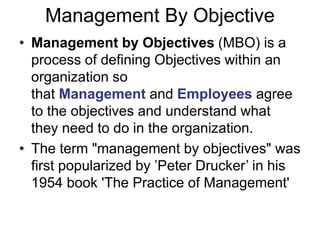
Management by objectives
- 1. Management By Objective • Management by Objectives (MBO) is a process of defining Objectives within an organization so that Management and Employees agree to the objectives and understand what they need to do in the organization. • The term "management by objectives" was first popularized by ’Peter Drucker’ in his 1954 book 'The Practice of Management'
- 2. Management By Objective • The essence of MBO is participative goal setting, choosing course of actions and decision making. An important part of the MBO is the measurement and the comparison of the employee’s actual performance with the standards set. Ideally, when employees themselves have been involved with the goal setting and choosing the course of action to be followed by them, they are more likely to fulfill their responsibilities.
- 3. Management By Objective • According to George S. Odiorne, the system of management by objectives can be described as a process whereby the superior and subordinate managers of an organization jointly identify its common goals, define each individual's major areas of responsibility in terms of the results expected of him, and use these measures as guides for operating the unit and assessing the contribution of each of its members
- 4. Unique features and advantages of the MBO process • The basic principle behind Management by Objectives (MBO) is for employees to have a clear understanding of the roles and responsibilities expected of them. They can then understand how their activities relate to the achievement of the organization's goal. MBO also places importance on fulfilling the personal goals of each employee.
- 5. Unique features and advantages of the MBO process • Some of the important features and advantages of MBO are: • 1. Motivation – Involving employees in the whole process of goal setting and increasing employee empowerment. This increases employee job satisfaction and commitment. • 2. Better communication and Coordination – Frequent reviews and interactions between superiors and subordinates helps to maintain harmonious relationships within the organization and also to solve many problems.
- 6. Unique features and advantages of the MBO process • 3. Clarity of goals • 4. Subordinates tend to have a higher commitment to objectives they set for themselves than those imposed on them by another person. • 5. Managers can ensure that objectives of the subordinates are linked to the organization's objectives
- 7. M B O - Domains and levels • Objectives can be set in all domains of activities (production, marketing, services, sales, R&D, human resources, finance, information systems etc.). • Some objectives are collective, for a whole department or the whole company, others can be individualized.
- 8. M B O - Practice • Objectives need quantifying and monitoring. Reliable ’M I S’ are needed to establish relevant objectives and monitor their "reach ratio" in an objective way. • Pay, Allowances and Performance linked Rewards (bonuses) are often linked to results in reaching the objectives. • Marketing Staff is normally Motivated to MBO practice as their results are Rewarded linked to their performance.
- 9. M B O - Limitations • There are several limitations to the assumptive base underlying the impact of managing by objectives, including: • 1. It over-emphasizes the setting of goals over the working of a plan as a driver of outcomes. • 2. It underemphasizes the importance of the environment or context in which the goals are set. That context includes everything from the availability and quality of resources, to relative buy-in by leadership and stake-holders. As an example of the influence of management buy-in as a contextual influencer, in a 1991 comprehensive review of thirty years of research on the impact of Management by Objectives, Robert Rodgers and John Hunter concluded that companies whose CEOs demonstrated high commitment to MBO showed, on average, a 56% gain in productivity. Companies with CEOs who showed low commitment only saw a 6% gain in productivity.
- 10. M B O - Limitations • 3. Companies evaluated their employees by comparing them with the "ideal" employee. Trait appraisal only looks at what employees should be, not at what they should do. • When this approach is not properly set, agreed and managed by organizations, self-centered employees might be prone to distort results, falsely representing achievement of targets that were set in a short-term, narrow fashion. In this case, managing by objectives would be counterproductive.
- 11. M B O - Limitations • The use of MBO must be carefully aligned with the culture of the organization. While MBO is not as fashionable as it was before, it still has its place in management today. The key difference is that rather than 'set' objectives from a cascade process, objectives are discussed and agreed upon. Employees are often involved in this process, which can be advantageous.
- 12. M B O – Overcoming Limitations • A saying around MBO -- "What gets measured gets done", ‘Why measure performance? Different purposes require different measures’ -- is perhaps the most famous aphorism of performance measurement; therefore, to avoid potential problems SMART and SMARTER objectives need to be agreed upon in the true sense rather than set.
- 13. M B O • M B O
- 14. M B O • M B O
- 15. M B O
